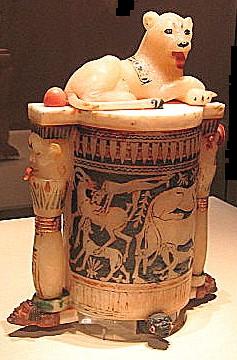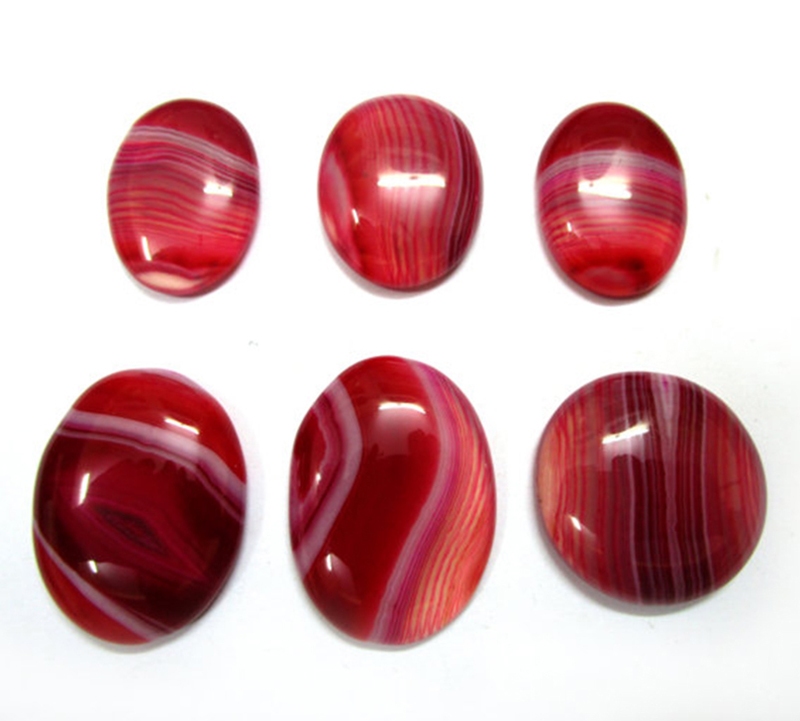|
Alabaster
Alabaster is a mineral or rock that is soft, often used for carving, and is processed for plaster powder. Archaeologists and the stone processing industry use the word differently from geologists. The former use it in a wider sense that includes varieties of two different minerals: the fine-grained massive type of gypsum and the fine-grained banded type of calcite.''More about alabaster and travertine'', brief guide explaining the different use of these words by geologists, archaeologists, and those in the stone trade. Oxford University Museum of Natural History, 2012/ref> Geologists define alabaster only as the gypsum type. Chemically, gypsum is a hydrous sulfate of calcium, while calcite is a carbonate of calcium. The two types of alabaster have similar properties. They are usually lightly colored, translucent, and soft stones. They have been used throughout history primarily for carving decorative artifacts."Grove": R. W. Sanderson and Francis Cheetham. "Alabaster", Grove ... [...More Info...] [...Related Items...] OR: [Wikipedia] [Google] [Baidu] |
Bast (mythology)
Bastet or Bast ( egy, bꜣstjt, cop, Ⲟⲩⲃⲁⲥⲧⲉ, Oubaste , Phoenician: 𐤀𐤁𐤎𐤕, romanized: ’bst, or 𐤁𐤎𐤕, romanized: bst) was a goddess of ancient Egyptian religion, worshipped as early as the Second Dynasty (2890 BCE). Her name also is rendered as B'sst, Baast, Ubaste, and Baset. In ancient Greek religion, she was known as Ailuros ( grc-koi, αἴλουρος "cat"). Bastet was worshipped in Bubastis in Lower Egypt, originally as a lioness goddess, a role shared by other deities such as Sekhmet. Eventually Bastet and Sekhmet were characterized as two aspects of the same goddess, with Sekhmet representing the powerful warrior and protector aspect and Bastet, who increasingly was depicted as a cat, representing a gentler aspect.Serpell, "Domestication and History of the Cat", p. 184. Name Bastet, the form of the name that is most commonly adopted by Egyptologists today because of its use in later dynasties, is a modern convention offering one pos ... [...More Info...] [...Related Items...] OR: [Wikipedia] [Google] [Baidu] |
Gypsum
Gypsum is a soft sulfate mineral composed of calcium sulfate dihydrate, with the chemical formula . It is widely mined and is used as a fertilizer and as the main constituent in many forms of plaster, blackboard or sidewalk chalk, and drywall. Alabaster, a fine-grained white or lightly tinted variety of gypsum, has been used for sculpture by many cultures including Ancient Egypt, Mesopotamia, Ancient Rome, the Byzantine Empire, and the Nottingham alabasters of Medieval England. Gypsum also crystallizes as translucent crystals of selenite. It forms as an evaporite mineral and as a hydration product of anhydrite. The Mohs scale of mineral hardness defines gypsum as hardness value 2 based on scratch hardness comparison. Etymology and history The word '' gypsum'' is derived from the Greek word (), "plaster". Because the quarries of the Montmartre district of Paris have long furnished burnt gypsum ( calcined gypsum) used for various purposes, this dehydrated gyp ... [...More Info...] [...Related Items...] OR: [Wikipedia] [Google] [Baidu] |
Calcite
Calcite is a carbonate mineral and the most stable polymorph of calcium carbonate (CaCO3). It is a very common mineral, particularly as a component of limestone. Calcite defines hardness 3 on the Mohs scale of mineral hardness, based on scratch hardness comparison. Large calcite crystals are used in optical equipment, and limestone composed mostly of calcite has numerous uses. Other polymorphs of calcium carbonate are the minerals aragonite and vaterite. Aragonite will change to calcite over timescales of days or less at temperatures exceeding 300 °C, and vaterite is even less stable. Etymology Calcite is derived from the German ''Calcit'', a term from the 19th century that came from the Latin word for lime, ''calx'' (genitive calcis) with the suffix "-ite" used to name minerals. It is thus etymologically related to chalk. When applied by archaeologists and stone trade professionals, the term alabaster is used not just as in geology and mineralogy, where it is ... [...More Info...] [...Related Items...] OR: [Wikipedia] [Google] [Baidu] |
Onyx
Onyx primarily refers to the parallel banded variety of chalcedony, a silicate mineral. Agate and onyx are both varieties of layered chalcedony that differ only in the form of the bands: agate has curved bands and onyx has parallel bands. The colors of its bands range from black to almost every color. Commonly, specimens of onyx contain bands of black and/or white. Onyx, as a descriptive term, has also been applied to parallel banded varieties of alabaster, marble, calcite, obsidian and opal, and misleadingly to materials with contorted banding, such as "Cave Onyx" and "Mexican Onyx". Etymology ''Onyx'' comes through Latin (of the same spelling), from the Ancient Greek , meaning "claw" or "fingernail". Onyx with flesh-colored and white bands can sometimes resemble a fingernail. The English word "nail" is cognate with the Greek word. Varieties Onyx is formed of bands of chalcedony in alternating colors. It is cryptocrystalline, consisting of fine intergrowths of the silica m ... [...More Info...] [...Related Items...] OR: [Wikipedia] [Google] [Baidu] |
Mesopotamia
Mesopotamia ''Mesopotamíā''; ar, بِلَاد ٱلرَّافِدَيْن or ; syc, ܐܪܡ ܢܗܪ̈ܝܢ, or , ) is a historical region of Western Asia situated within the Tigris–Euphrates river system, in the northern part of the Fertile Crescent. Today, Mesopotamia occupies modern Iraq. In the broader sense, the historical region included present-day Iraq and Kuwait and parts of present-day Iran, Syria and Turkey. The Sumerians and Akkadians (including Assyrian people, Assyrians and Babylonians) originating from different areas in present-day Iraq, dominated Mesopotamia from the beginning of recorded history, written history () to the fall of Babylon in 539 BC, when it was conquered by the Achaemenid Empire. It fell to Alexander the Great in 332 BC, and after his death, it became part of the Greek Seleucid Empire. Later the Arameans dominated major parts of Mesopotamia (). Mesopotamia is the site of the earliest developments of the Neolithic Revolution from aroun ... [...More Info...] [...Related Items...] OR: [Wikipedia] [Google] [Baidu] |
Lioness Bast Cosmetic Jar 83d40m Tut Burial Artifact
A lioness is a female lion. Lioness(es) may also refer to: Music * Lioness Records, a British record label * Lioness (band), a Canadian indie rock band ** ''Lioness'' (EP), their 2008 EP * ''Lioness'' (Sivert Høyem album), 2016 * ''Lioness'' (Beccy Cole album), 2018 * ''The Lioness'' (album), a 2000 album by Songs: Ohia, or its title song * '' Lioness: Hidden Treasures'', a 2011 posthumous compilation album by Amy Winehouse Sports teams United Kingdom *England women's national football team * England women's national rugby league team * Great Britain women's national rugby league team * Millwall Lionesses L.F.C., an English women's football club *London City Lionesses, an English women's football club Elsewhere *Argentina women's national field hockey team * Kenya women's national rugby sevens team Other uses * ''Lioness'' (film), a documentary about the American servicewomen in Iraq *Team Lioness, female teams of United States Marines during the Iraq War * ''The Lioness' ... [...More Info...] [...Related Items...] OR: [Wikipedia] [Google] [Baidu] |
Effervescence
Effervescence is the escape of gas from an aqueous solution and the foaming or fizzing that results from that release. The word effervescence is derived from the Latin verb ''fervere'' (to boil), preceded by the adverb ''ex''. It has the same linguistic root as the word fermentation. Effervescence can also be observed when opening a bottle of champagne, beer or carbonated beverages such as some carbonated soft drinks. The visible bubbles are produced by the escape from solution of the dissolved gas (which itself is not visible while dissolved in the liquid). Although CO2 is most common for beverages, nitrogen gas is sometimes deliberately added to certain beers. The smaller bubble size creates a smoother beer head. Due to the poor solubility of nitrogen in beer, kegs or widgets are used for this. In the laboratory, a common example of effervescence is seen if hydrochloric acid is added to a block of limestone. If a few pieces of marble or an antacid tablet are put in hydroch ... [...More Info...] [...Related Items...] OR: [Wikipedia] [Google] [Baidu] |
Europe
Europe is a large peninsula conventionally considered a continent in its own right because of its great physical size and the weight of its history and traditions. Europe is also considered a subcontinent of Eurasia and it is located entirely in the Northern Hemisphere and mostly in the Eastern Hemisphere. Comprising the westernmost peninsulas of Eurasia, it shares the continental landmass of Afro-Eurasia with both Africa and Asia. It is bordered by the Arctic Ocean to the north, the Atlantic Ocean to the west, the Mediterranean Sea to the south and Asia to the east. Europe is commonly considered to be separated from Asia by the watershed of the Ural Mountains, the Ural River, the Caspian Sea, the Greater Caucasus, the Black Sea and the waterways of the Turkish Straits. "Europe" (pp. 68–69); "Asia" (pp. 90–91): "A commonly accepted division between Asia and Europe ... is formed by the Ural Mountains, Ural River, Caspian Sea, Caucasus Mountains, and the Blac ... [...More Info...] [...Related Items...] OR: [Wikipedia] [Google] [Baidu] |
Mohs Scale Of Mineral Hardness
The Mohs scale of mineral hardness () is a Qualitative property, qualitative ordinal scale, from 1 to 10, characterizing scratch hardness, scratch resistance of various minerals through the ability of harder material to scratch softer material. The scale was introduced in 1812 by the German geologist and Mineralogy, mineralogist Friedrich Mohs, in his book ''"Versuch einer Elementar-Methode zur naturhistorischen Bestimmung und Erkennung der Fossilien"''; it is one of several definitions of Hardness comparison, hardness in materials science, some of which are more quantitative. The method of comparing hardness by observing which minerals can scratch others is of great antiquity, having been mentioned by Theophrastus in his treatise ''On Stones'', , followed by Pliny the Elder in his ''Natural History (Pliny), Naturalis Historia'', . The Mohs scale is useful for identification of minerals in the field, but is not an accurate predictor of how well materials endure in an industrial s ... [...More Info...] [...Related Items...] OR: [Wikipedia] [Google] [Baidu] |
Hydrochloric Acid
Hydrochloric acid, also known as muriatic acid, is an aqueous solution of hydrogen chloride. It is a colorless solution with a distinctive pungent smell. It is classified as a strong acid. It is a component of the gastric acid in the digestive systems of most animal species, including humans. Hydrochloric acid is an important laboratory reagent and industrial chemical. History In the early tenth century, the Persian physician and alchemist Abu Bakr al-Razi ( 865–925, Latin: Rhazes) conducted experiments with sal ammoniac ( ammonium chloride) and vitriol (hydrated sulfates of various metals), which he distilled together, thus producing the gas hydrogen chloride. In doing so, al-Razi may have stumbled upon a primitive method for producing hydrochloric acid, as perhaps manifested in the following recipe from his ("The Book of Secrets"): However, it appears that in most of his experiments al-Razi disregarded the gaseous products, concentrating instead on the color c ... [...More Info...] [...Related Items...] OR: [Wikipedia] [Google] [Baidu] |
George Perkins Merrill
George Perkins Merrill (May 31, 1854 – August 15, 1929) was an American geologist, notable as the head curator from 1917 to 1929 of the Department of Geology, United States National Museum (now the National Museum of Natural History of the Smithsonian Institution). Biography George Perkins Merrill was born in Auburn, Maine on May 31, 1854. He was educated at the University of Maine (B.S., 1879; Ph.D., 1889), took a post-graduate courses of study and was assistant in chemistry at Wesleyan University, Connecticut (1879–1880), and subsequently studied at Johns Hopkins (1886–1887). In 1881 he became assistant curator at the National Museum, Washington, D.C. He also served as professor of geology and mineralogy at the Corcoran Scientific School of Columbian University (now George Washington University) from 1893 to 1916, and was appointed head curator of the department of geology at the National Museum in 1897. In 1922 he was elected to the National Academy of Sciences. He wr ... [...More Info...] [...Related Items...] OR: [Wikipedia] [Google] [Baidu] |





